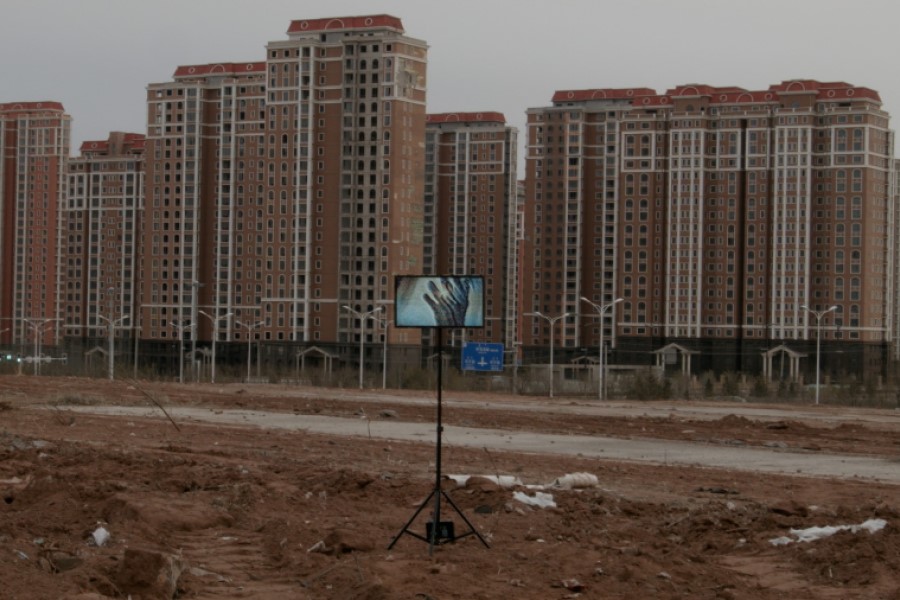TRENT CRAWFORD (VIC)
Trent Crawford adapts and hacks visual technologies, creating a complex, anxious vision of our technologically shaped and mediated world. Liquidity, 2016, is a good entry point to his work. It comprises four flat LCD screens, bound together and hanging, like books in an old-fashioned book strap. Arranged so they imperfectly overlap, each screen displays the same video of a blue fluid, perhaps just water, its surface sloshing against a glass pane. This simple installation produces a vivid illusion; strapped together, the monitors create the impression of a single transparent three-dimensional volume of liquid in motion. One could imagine picking up and carrying away this tank of pixelated water, or pouring it out. It’s an elegant and surprising transformation which encourages thoughts about the interplay of representation and reality in the digital era. Liquidity communicates directly and meaningfully to all kinds of viewers, and it exemplifies the combination of technical mastery and visual poetry that runs throughout Crawford’s practice. But there is much more to be said about the breadth of his technical accomplishment and the attitudes expressed in his work.
The range of Crawford’s technological interests is apparent in Newclear, 2017, which uses analogue technologies to elegant and powerful effect. Newclear is a series of four photographs. Each vertical slice of these images reproduces a corresponding slice of a still from a film of a 1955 nuclear test, known as Apple-2, showing the effect of a nuclear blast on recognisably suburban 1950s US buildings. To the left of each image are slices from the earlier footage, showing intact buildings; to the right, the devastating effects of the blasts. In quite a literal sense, these are photographs of time as much as space. They are examples of strip or slit photography, achieved using a moving ‘slit’ device Crawford built in the darkroom. The technologies here are resolutely analogue, and the subject is appropriately twentieth century. But Newclear feels contemporary. The doomed toy-town buildings now evoke nostalgia, and the grainy, blurred aesthetic puts one in mind of painters Gerhard Richter and Luc Tuymans and their themes of historical trauma. With the continued existence of nuclear weapons, anxiety about nuclear dangers has diffused but not disappeared, and Newclear crystallises that residue of unease.
Other works of Crawford’s also express anxieties about technology. Transparency – meant in a variety of senses – is an organising principle of a number of his works. As we have seen, Liquidity plays with impressions of transparency. Crawford also takes apart LCD monitors, rearranging their screens – which, once removed from their housings, are glassily transparent – and the neon strip lights that backlight them. These feature in 5:4, 2017, and also in a work that takes its long title from a poem by Robert Fulghum: And it is still true, no matter how old you are, when you go out into the world it is best to hold hands and stick together (2020). In these pieces, the neon lights are reassembled into asterisks or crosses and placed behind the transparent LCD screens. In And it is still true…, the image shows superzoom footage scanning Melbourne hotel windows and rooftops. Objects – and occasionally people – are visible through the windows. Behind the screen, a cross of neon lights incompletely backlights the image, suggesting the lights in a scanner, or crosshairs. Visually, the effect is one of complexly interacting layers of information, arousing a sense of anxiety and vulnerability. Here the theme of transparency takes on another meaning: with the availability of information comes erosion of privacy, and with that comes a diffused and ever-present anxiety that can verge on paranoia.
UFOs are another fascination for Crawford. Since the 1950s, the notion of UFOs has come in and out of vogue in both counterculture and popular culture. UFOs, as I think of them, are avatars for anxieties and desires for which the dominant culture of the day provides no outlet. The installation The Anomalous Image (2019) presents, among other elements, large photographic images of what Crawford calls “anomalous entities” which he says have appeared in response to his attempts – emulating Sydney UFOlogist Zdenko Mucibabic – to telepathically summon UFOs. Images of UFOs appear elsewhere in his work, such as in Cataract (HIJ - NGS), 2020, as do images of phosphenes, the somewhat-UFO-shaped blobs that appear in the visual field when one presses one’s eyes (Phosphene, 2020). That all points to further layers of significance in Crawford’s work. Perhaps this is cultural critique – an ironic anthropology of contemporary counterculture. But if here too UFOs are avatars for otherwise-difficult-to-express anxieties and desires, it’s reasonable to think that for Crawford they indicate an appreciation for the uncanny, and a yearning for order and meaning beyond that provided by a secular technological and material worldview.
How to square the pragmatic hacker of technology and analyst of technological anxieties with an artist apparently in intimate communion with extra-terrestrial presences? To my mind, Crawford shares something with those early modernists who saw an analysis of modernity as of a piece with more esoteric concerns. So too Crawford’s different approaches can be seen as aspects of a single, developing worldview, a contemporary digital Weltanschauung, in which all sides of human life and feeling will find their expression.
Essay by Michael Newall.
Michael Newall is a writer whose work spans philosophy, art history and aesthetics. His book, A Philosophy of the Art School (Routledge, 2021), is out now in paperback. He currently lives and works in Tarntanya/Adelaide.
Trent Crawford graduated from the Victorian College of the Arts with a Bachelor of Fine Arts (Honours) in 2017. He has shown in solo and group exhibitions in Melbourne, interstate and overseas. He works with photography, video, and installation to consider the effect images and image-based technology have on human perception and agency. He lives and works in Naarm/Melbourne. Artist's website: trentcrawford.net

